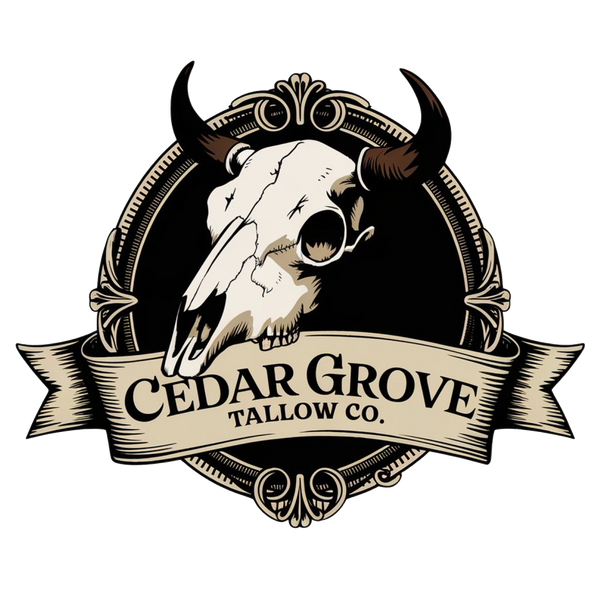Collapsible content
Is tallow good for skin?
Yes! Tallow is fantastic as skincare – the fatty acids are extremely compatible with the oil that our skin naturally produces, which is why our skin is able to use and absorb tallow so effectively. All of the fatty acids in tallow are beneficial for moisture retention and skin healing - which is why it makes a wonderful moisturizer for so many people, especially those with sensitive skin!
What can I make with tallow?
Tallow is so versatile – you can use it any skincare formulation just like you would use shea butter, cocoa butter, or coconut oil. It can be used neat or blended with liquid oils and then whipped to create an ultra-light whipped balm. It can be infused
with botanicals and medicinal herbs to create a healing salve. You can use it to
create luxurious, skin-smoothing lotions and creams. You can add it to shampoo
and conditioner bars for a dose of hair-loving moisture. You can mix it with beeswax to create non-toxic, slow-burning candles. The possibilities are endless!
What does tallow smell like?
Natural, minimally-processed tallow does have a slight scent- it comes from an animal, after all! However, when prepared properly, tallow will have a slight buttery, fatty scent that dissipates quickly once applied. It shouldn't smell overly beefy or like coked meat.
Can you explain your processing times?
We get it – our fulfillment times are longer than the competition. This is because our entire process is done by hand!
From travelling to pick up suet from our farming partners, to cleaning
and picking apart any unwanted pieces, and then chopping it all up into small pieces so it can be rendered slowly over low heat, then onto to straining, cooling, and finally to packaging up your order and shipping it out. It takes about 30 hours to complete one batch from start to finish, and we aren’t interested in mass-producing tallow because we value quality over quantity. Real humans do all the work here, there is nothing automated and there are no machines.
We believe this is a huge part of what sets us apart from other suppliers!
Do you use trim fat in your tallow? Are there any other ingredients added?
Never.
Our tallow is made with pure suet fat, nothing else. We do not add any other ingredients to our rendering process or to the finished product.
Why are some batches of tallow hard, and some softer?
Typically suet tallow is hard at room temp, however the texture can vary depending on the breed and age of the cattle:
Suet tallow from older cows always come out softer than suet tallow from younger cows.
Variance is to be expected in this industry - some batches will be rock hard and some will be softer.
My tallow arrived melted and/or grainy. Can you tell me why and how to fix it?
Long story short, the texture of your tallow changed during shipping due to the heat in warmer months.
There are 0 additives, stabilizers, thickeners, etc. added to our tallow and tallow will naturally start to soften around 80 degrees, and begin to melt around 95 degrees. Postal distribution centers, long-haul trucks, and delivery vehicles get vary warm in the summer – some over 120 degrees on a typical summer day. When tallow partially melts during shipping, the fatty acids separate and it won’t solidify back into the uniform, solid texture that you’re expecting. Some of you may have experienced this if you have ever tried cooling your own tallow on the counter instead of in the fridge or freezer – it’s grainy, soft and looks like it’s trying to separate. I know many makers have experienced the same issue as well when shipping their tallow balms to customers; they create a beautiful product but when it reaches the customer it's melted, lost it's shape, and turned grainy. The same happens to our tallow.
If you receive your order and the texture is off, there are a few things you can do to fix it:
The first (and quickest method) is to put it into a bowl and use an immersion blender to force the fatty acids back together. It has to be an immersion blender – a hand or stand mixer won’t work. Blend until it reaches a creamy, uniform consistency, and then place the bowl into the fridge and leave it there overnight. The next morning take it out and let it come to room-temp; your tallow will be solid again.
The second method is to put your tallow into a pot on the stove over medium-high heat and melt it down completely. Stir occasionally while melting to ensure the heat is uniform. Once melted, transfer it to a heat-proof bowl and place it in the freezer overnight. The next morning take it out and let it come to room-temp; your tallow will be solid again.
If you have any questions, please don’t hesitate to reach out. Our team is always available to help troubleshoot and figure out a way to make our tallow work for you.
Can I use your tallow for cooking?
Right now, we can’t legally sell our tallow as food-grade, since our facility is not yet USDA certified and that is a requirement when selling tallow, which they consider a by-product of meat. However, our process isn’t going to change once our facility is approved by the USDA- we already follow all of the safe food handling and GMP guidelines!
